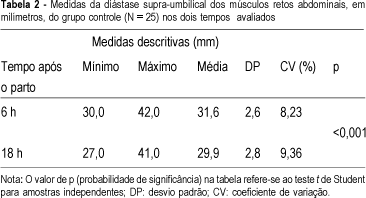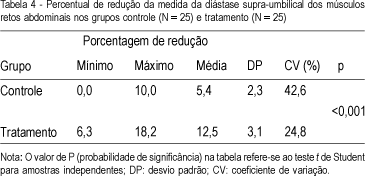Purpose: to check if physiotherapy immediately after childbirth may contribute to early diastasis reduction. Methods: longitudinal and randomized study with 50 parturient women recruited in the Maternidade-Escola Hilda Brandão of the Santa Casa of Belo Horizonte, from April to September 1998. The control group (N = 25) was submitted to evaluation and measurement (6 h and 18 h after labor), and the treatment group (N = 25) was submitted to the same evaluation and measurement as above, as well as to a protocol for physiotherapeutic assistance, 6 and 18 h after labor. For the evaluations, a pachymeter, a precision instrument, was used to measure diastasis. Results: at 18 h after parturition, the control group presented a diastasis reduction of 5.4%, and the treatment group of 12.5%, as related to the first measure (6 h after delivery) (p<0.001, with a confidence interval of 99%). Conclusions: these results show that the physiotherapeutic assistance immediately after childbirth determines a significant reduction in the diastasis of the recti abdominis muscles (DRAM) after every treatment session, as well as a relevant reduction when compared to the control group, positively contributing to the earlier recovery of the recti abdominis muscles.
Diastasis recti abdominis; Puerperium; Physiotherapy; Pregnancy

 Physiotherapy for reduction of diastasis of the recti abdominis muscles in the postpartum period
Physiotherapy for reduction of diastasis of the recti abdominis muscles in the postpartum period



